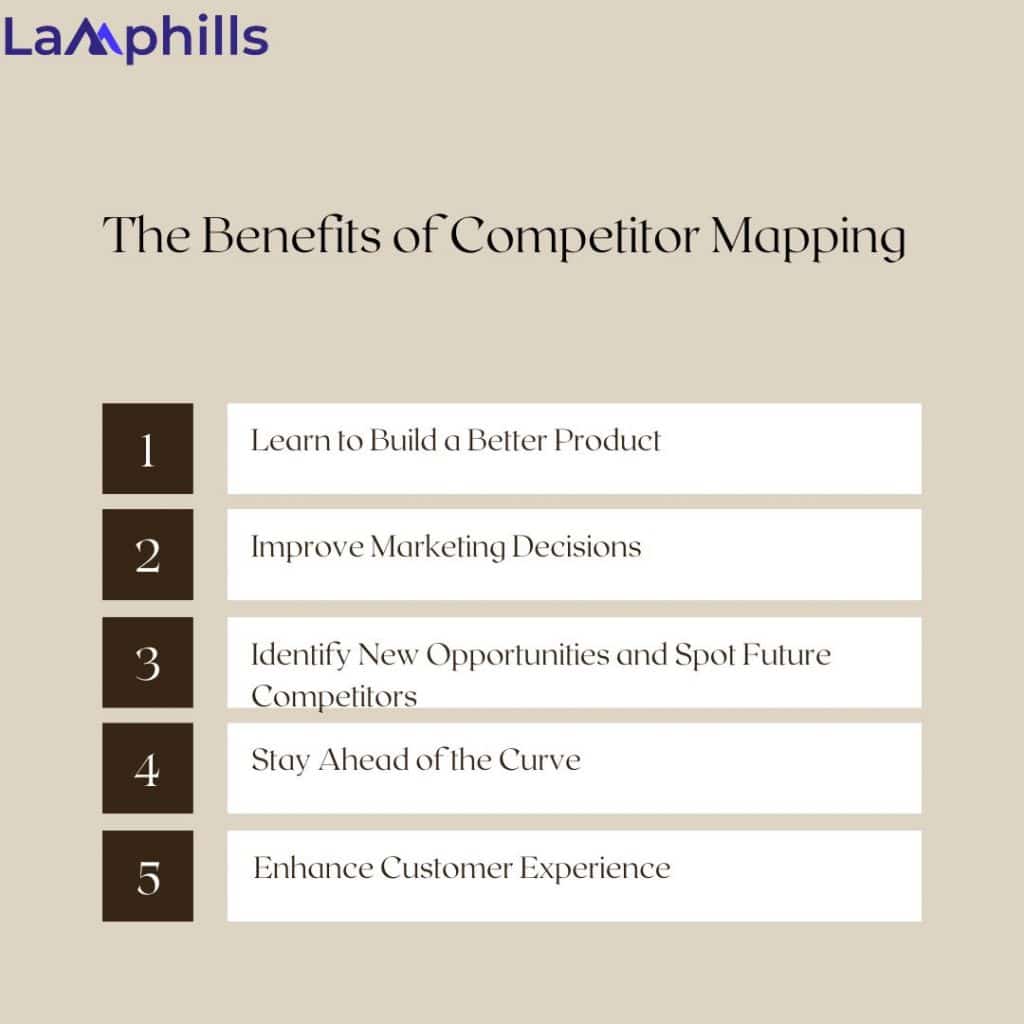Are you ready to elevate your brand’s PR strategy using competitors mapping template? By effectively mapping out your competition, you can identify trends and unique qualities that differentiate your brand, allowing you to cater to customer needs more precisely. This systematic approach enables you to gain critical insights into your rivals’ strengths and weaknesses, positioning your brand for success. In this article, I’m going to define competition mapping, how to create one, the benefits of competition mapping, and how to use it for your brand’s PR strategy.
Key Points
- Begin by pinpointing your direct competitors and analyzing their product offerings, target demographics, and marketing strategies to establish a relevant competitive landscape.
- Utilize a SWOT analysis to assess your strengths, weaknesses, opportunities, and threats in relation to your competitors, providing a comprehensive view of your market positioning.
- Learn how competitor mapping helps refine your product, improve marketing decisions, identify new opportunities, and enhance customer experiences by observing competitors’ strategies.
- Organize and visualize your findings using competitors mapping template, enabling you to compare your strategies against your competitors and uncover areas for growth.
What Is Competitor Mapping?
Competitor mapping—also known as competitive analysis—is a powerful, systematic process that businesses use to assess their competitors’ strengths, weaknesses, and market positioning. This approach provides a framework for understanding how your rivals operate, from their product strategies to pricing tactics, all with the goal of carving out a competitive advantage. For anyone looking to make informed, data-driven decisions, competitor mapping delivers critical insights that reveal where your business stands in the broader competitive landscape.
At its core, competitor mapping is about visualizing how different companies, including your own, stack up across key performance indicators. It involves analyzing competitive benchmark data, such as product pricing or perceived benefits, which helps businesses set realistic goals and define metrics that are actually relevant to the market.
With these data points in mind, creating a competitors mapping template can be highly effective for organizing and contextualizing this information.
How to Create a Detailed Competitors Mapping Template for Your Business
Building a competition mapping strategy for your business offers invaluable insights, helping you to understand the competitive landscape and position your brand more effectively. Here’s an in-depth guide on how to create comprehensive competitors mapping template to stay ahead:
#1. Identify Key Competitors
Begin by pinpointing five or fewer direct competitors—those that provide similar products or services. These are the companies that are most relevant to your market position, so identifying them accurately is crucial. Conduct thorough online research to learn what they offer, their product quality, target demographics, and brand messaging. Pay attention to the language they use to reach their audience and the specific needs they address. Observing their marketing channels—such as social media, newsletters, and blogs—can reveal what resonates most with their audience, which can guide your brand’s own content strategy.
#2. Select a Focus Area for Analysis
Choose a specific area to center your competitors mapping template on, such as product features, customer service quality, or social media engagement. Focusing on a single area allows you to gain a deeper understanding of where each competitor excels or falls short. If you’re examining social media strategies, for example, study how often each competitor posts, the type of content they produce (videos, graphics, stories), and the level of audience interaction they receive.
Consider whether their tone is professional, friendly, or authoritative, and assess if this aligns well with their audience. Gathering these insights can help you adjust your own social media approach to capture attention more effectively.
#3. Define and Compare Key Attributes
Outline your product or service’s defining features and strengths, focusing on what sets you apart from competitors. This step is essential for your competition mapping template because it lets you directly compare your brand’s attributes against others. Start by listing your product’s core benefits, such as superior quality, unique design, or enhanced usability, and think about how customers might view them compared to the competition.
Additionally, research how competitors’ products are perceived by customers through reviews, social media, and testimonials. By comparing these insights, you can refine your brand voice and messaging to emphasize your unique strengths and resonate more strongly with your target audience.
#4. Identify and Document Areas for Improvement
Honest assessment is critical for competition mapping to be effective. Look closely at any gaps in your offerings where competitors might have an advantage, such as more advanced features or better customer service. List specific aspects you can improve, such as adding a new feature, enhancing product packaging, or refining customer support practices.
This comparison isn’t just about identifying weaknesses—it’s about discovering actionable ways to align your product or service more closely with market demands. Incorporating these changes can demonstrate to investors and stakeholders that your brand is committed to continuous improvement and adaptability, which are key components of competitive success.
#5. Organize and Visualize Your Findings
After gathering all relevant information, compile it into competitors mapping template that makes the data easy to interpret at a glance. One approach is to create a two-column list or a chart: in one column, summarize the competitor’s information; in the other, list your brand’s data for direct comparison. You might also use a series of graphs, such as scatter plots, line charts, or comparison grids, to visualize metrics like market share, customer satisfaction, or pricing strategies.
By creating a detailed visual representation of these comparisons, you gain a clear, objective view of where your brand stands in the market. For example, if you notice a competitor’s social media engagement far exceeds yours, this could inspire you to develop a plan for boosting your social media presence and interaction.
#6. Brainstorm and Implement Strategic Improvements
The final step in the competition mapping process involves brainstorming and prioritizing actionable steps to bridge any identified gaps. Develop a list of practical initiatives, such as improving product features, expanding customer service hours, or implementing a new social media strategy.
Start by choosing one or two of the most impactful ideas, and set measurable goals for them. Save the other ideas for future growth phases as your business evolves. Regularly updating your competition mapping template with new data will allow you to track progress over time, ensuring your brand stays aligned with market trends and continues to improve.
How Can You Use Competitors Mapping in PR Campaigns?
The following are steps to utilize when using competitors mapping in PR campaigns:
#1. Round Up Your Competitors
The first step in effective competitor mapping is identifying the main players in your field. Begin by locating businesses that directly compete with yours, offering similar products or services—such as the well-known competition between McDonald’s and KFC. Include indirect competitors who offer alternatives in the same category; for instance, a coffee brand versus a bottled water company, both satisfying a need for beverages.
Don’t forget replacement competitors, which can be challenging to identify, as they use similar resources but serve different purposes, like a book and a video game. Finally, pay attention to SEO competitors, brands that may not be in your industry but compete with you in search engine results, like Ryanair and Skyscanner. Update this list frequently, as new competitors constantly emerge.
#2. Choose an Area of Your Business to Review
Narrowing down your competitor mapping focus is essential to avoid overwhelming yourself. Decide if you want to analyze social media presence, product range, or pricing policies. By focusing on one area, you can streamline your research and make it more relevant. For example, if you’re creating competitors mapping template to analyze social media, you might track competitors’ engagement rates, follower counts, and content strategies. Defining a specific area helps you target the data collection to support actionable insights.
#3. Conduct a SWOT Analysis
A SWOT analysis is an invaluable tool in competition mapping. It breaks down into four categories: strengths, weaknesses, opportunities, and threats. Strengths and weaknesses are internal, such as product quality or customer service, while opportunities and threats are external, like evolving customer preferences or economic shifts. Conducting a SWOT analysis provides a big-picture perspective of both the competitive landscape and your own market positioning.
#4. List Your Brand’s Best Traits
Once you’ve mapped out your competitors, focus on what makes your brand stand out. Ask yourself questions like: What aspects of my product or service do customers love? How do we differ from competitors? Tools like Determ can give you an unbiased view of your brand’s reputation by monitoring social media sentiment and categorizing mentions as positive, neutral, or negative. This information helps you identify your competitive mapping strengths, allowing you to build on them.
#5. Identify Areas for Improvement
Examine your competitors’ approaches to identify where you could improve. Look at what they discuss, the content they produce, and how they engage their audience. With the help of a social media monitoring tool, you can quickly gather this data from various online sources.
Use this information to create competitors mapping template that compares your brand’s performance with key competitors. By compiling a competitive report, you can effortlessly spot areas for growth and opportunities to fine-tune your strategy.
#6. Create Your Competitor Map
After gathering all relevant data, you’re ready to create your competitor map. Use a table or chart to visualize your findings, listing competitors’ strategies on one side and your approach on the other. This allows you to identify market gaps and potential areas where you can better meet customer needs, setting your brand apart.
The Benefits of Competitor Mapping

The benefit of competitor mapping include:
#1. Learn to Build a Better Product
When it comes to competitor mapping, one of the most valuable insights you gain is understanding how to refine your product. While copying isn’t the goal, observing competitors’ strengths and weaknesses can help you make smarter improvements. Take a close look at their products and services.
Read customer reviews, browse their websites, or even ask your audience about their experience with competing brands. These insights can reveal areas where you might improve or features that could set you apart, guiding you to create a better product that resonates with your target audience.
#2. Improve Marketing Decisions
Effective marketing relies on understanding what resonates in your industry, and competitive mapping can provide just that. Analyzing how other businesses in your field market their products helps you shape a strategy that’s unique and impactful. Rather than guessing, you can develop campaigns informed by real-world examples—helping you create messages and tactics that connect with your target market and differentiate your brand in a way that’s truly engaging.
#3. Identify New Opportunities and Spot Future Competitors
As you delve into competitor mapping, it’s essential to watch for indirect competitors—those brands that might not seem like a threat but could chip away at your market share. At the same time, competitor analysis often reveals new opportunities within your industry. You may discover market segments or product niches that are underserved or even unnoticed by others. By staying proactive, competition mapping enables you to uncover growth areas that could give you a strong competitive edge.
#4. Stay Ahead of the Curve
Keeping an eye on competitors’ latest moves helps you stay up-to-date with industry trends and innovations. Product launches, new marketing channels, or fresh tactics are all signals worth monitoring. With competitor mapping, you gain insight into what works—and what doesn’t—without necessarily following their lead. Instead, try to understand the “why” behind their actions, allowing you to tailor your strategies in a way that’s a better fit for your own product or service.
#5. Enhance Customer Experience
Lastly, one of the most rewarding benefits of competition mapping is learning how to elevate your own customer service. By assessing competitors’ approaches to customer care, you’ll identify gaps that your brand can fill. Take note of customer complaints about other brands, and focus on ways you could go beyond their expectations.
Offering a superior customer experience strengthens relationships with your audience, turning them into loyal advocates for your brand.
What Is a Strategic Group Map?
A strategic group map is a tool that helps businesses visualize the competitive positions of their industry rivals. A group of rivals with similar strategies and business models are known as a strategic group.
What Is an Example of Competitive Mapping Analysis?
Competitive analysis example:
To do so, you would: Step 1: Use Google to compile a list of your competitors. Steps 2, 3, and 4: Use your competitors’ websites, as well as SEO analysis tools like Ahrefs, to deep-dive into the service offerings and marketing strategies of each company.
What Is a Competition Matrix?
A competitive matrix is a way to visualize your competitor analysis. There are different competitive matrices you can use to compare yourself to your competitors. You can use a competitive matrix to identify strengths, weaknesses, opportunities, or threats to your company.
What Is Competition Mapping?
Competition mapping, also known as competitive analysis, is a systematic process of researching and analyzing your competitors to identify their strengths and weaknesses, understand their market positioning, and develop effective strategies to gain your own competitive advantage.
Conclusion
Using a competitors mapping template with these focus areas can help you systematically track and compare the essential components of market competition. This approach doesn’t just provide an overview of where competitors stand but also helps pinpoint specific, actionable steps to elevate your brand’s presence in the market.
By following these steps, you’ll use competitor mapping to boost your PR strategy. This process aligns your products with market trends, highlights unique features that differentiate your brand, and positions you for improved market performance.
Related Articles
- How to Use Strategic Relationships to Enhance Your Marketing Strategy
- Guide To Field Marketing: Stronger Customer Connections in 2024
- Your Ultimate Guide to Effective Stakeholder Management: Best Practices
- The 12 Best Competitive Intelligence Tools to Gain a Strategic Advantage in 2024






